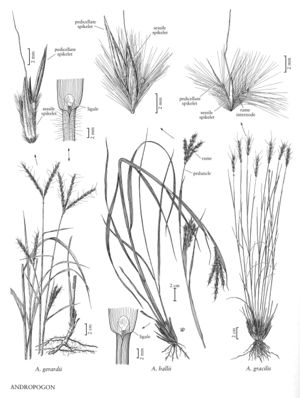Difference between revisions of "Andropogon gracilis"
FNA>Volume Importer |
FNA>Volume Importer |
||
| Line 7: | Line 7: | ||
|synonyms={{Treatment/ID/Synonym | |synonyms={{Treatment/ID/Synonym | ||
|name=Schizachyrium sericatum | |name=Schizachyrium sericatum | ||
| − | |authority= | + | |authority= |
| + | |rank=species | ||
}} {{Treatment/ID/Synonym | }} {{Treatment/ID/Synonym | ||
|name=Schizachyrium gracile | |name=Schizachyrium gracile | ||
| − | |authority= | + | |authority= |
| + | |rank=species | ||
}} | }} | ||
|hierarchy=Poaceae;Poaceae subfam. Panicoideae;Poaceae tribe Andropogoneae;Andropogon;Andropogon sect. Leptopogon;Andropogon gracilis | |hierarchy=Poaceae;Poaceae subfam. Panicoideae;Poaceae tribe Andropogoneae;Andropogon;Andropogon sect. Leptopogon;Andropogon gracilis | ||
| Line 23: | Line 25: | ||
-->{{Treatment/Body | -->{{Treatment/Body | ||
|distribution=Puerto Rico;Virgin Islands;Fla. | |distribution=Puerto Rico;Virgin Islands;Fla. | ||
| − | |discussion=<p>Andropogon gracilis grows on oolite in openings and rocky margins of pine woodlands of southern Florida and the West Indies. Although not uncommon, it is frequently overlooked. It has sometimes been placed in Schizachyrium because of its solitary rames.</p> | + | |discussion=<p><i>Andropogon gracilis</i> grows on oolite in openings and rocky margins of pine woodlands of southern Florida and the West Indies. Although not uncommon, it is frequently overlooked. It has sometimes been placed in <i>Schizachyrium</i> because of its solitary rames.</p> |
|tables= | |tables= | ||
|references= | |references= | ||
| Line 32: | Line 34: | ||
-->{{#Taxon: | -->{{#Taxon: | ||
name=Andropogon gracilis | name=Andropogon gracilis | ||
| − | |||
|authority=Spreng. | |authority=Spreng. | ||
|rank=species | |rank=species | ||
| Line 39: | Line 40: | ||
|basionyms= | |basionyms= | ||
|family=Poaceae | |family=Poaceae | ||
| − | |illustrator=Linda A. Vorobik | + | |illustrator=Linda A. Vorobik;Hana Pazdírková |
| + | |illustration copyright=Utah State University | ||
|distribution=Puerto Rico;Virgin Islands;Fla. | |distribution=Puerto Rico;Virgin Islands;Fla. | ||
|reference=None | |reference=None | ||
| Line 45: | Line 47: | ||
|publication year= | |publication year= | ||
|special status= | |special status= | ||
| − | |source xml=https:// | + | |source xml=https://jpend@bitbucket.org/aafc-mbb/fna-data-curation.git/src/f50eec43f223ca0e34566be0b046453a0960e173/coarse_grained_fna_xml/V25/V25_1576.xml |
|subfamily=Poaceae subfam. Panicoideae | |subfamily=Poaceae subfam. Panicoideae | ||
|tribe=Poaceae tribe Andropogoneae | |tribe=Poaceae tribe Andropogoneae | ||
Revision as of 21:35, 16 December 2019
Plants densely cespitose. Culms 20-60 cm, wiry, glabrous. Sheaths smooth; ligules to 1.4 mm; blades to 45 cm long, to 4 mm wide, involute and filiform, or folded. Inflorescence units 3-50+ per culm; peduncles 2-13.2 cm, with 1 rame; rames 2-4 cm, usually long-exserted at maturity; internodes densely pubescent, hairs to 8 mm. Sessile spikelets 4-6 mm; lower glumes scabrous in the distal 1/2; awns 11-20 mm. Pedicellate spikelets reduced to an awned or unawned glume, sterile. 2n = 40.
Distribution
Puerto Rico, Virgin Islands, Fla.
Discussion
Andropogon gracilis grows on oolite in openings and rocky margins of pine woodlands of southern Florida and the West Indies. Although not uncommon, it is frequently overlooked. It has sometimes been placed in Schizachyrium because of its solitary rames.
Selected References
None.
